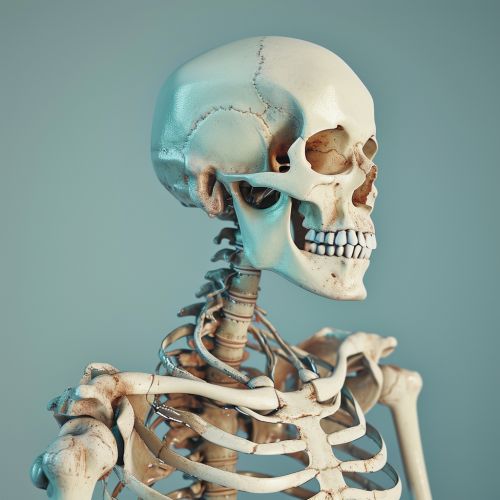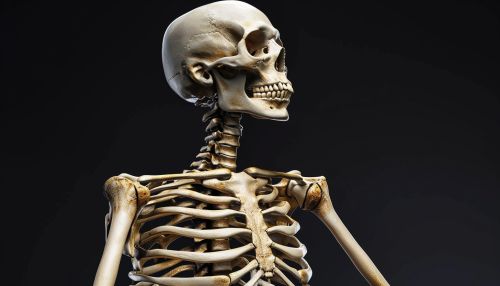Musculoskeletal system
Overview
The musculoskeletal system is a complex network of tissues and organs that includes the bones, muscles, tendons, ligaments, joints, cartilage, and other connective tissues. It provides form, support, stability, and movement to the body. This system is responsible for the physical framework of the body and the mechanics of body movement.


Structure
Bones
The bones are the rigid structures that make up the skeleton. They provide support for the body, protect vital organs, and work with the muscles to produce movement. The human body has 206 bones, which are categorized into two groups: the axial skeleton and the appendicular skeleton.
Axial Skeleton
The axial skeleton consists of 80 bones and includes the skull, vertebral column, and thoracic cage. It forms the central core of the body and protects the brain, spinal cord, and the organs within the thorax.
Appendicular Skeleton
The appendicular skeleton consists of 126 bones and includes the pectoral girdles, upper limbs, pelvic girdle, and lower limbs. It facilitates movement and interaction with the surrounding environment.
Muscles
The muscles are the tissues that produce force and motion. They work with the bones to move the body. There are three types of muscles in the human body: skeletal, smooth, and cardiac muscles.
Skeletal Muscles
Skeletal muscles are attached to the bones and are responsible for voluntary movements. They are striated, meaning they have a banded appearance when viewed under a microscope.
Smooth Muscles
Smooth muscles are found in the walls of organs and structures such as the esophagus, stomach, intestines, bronchi, uterus, urethra, blood vessels, and the arrector pili in the skin. They are responsible for involuntary movements.
Cardiac Muscles
Cardiac muscles are found in the heart and are responsible for pumping blood throughout the body. Like skeletal muscles, they are striated, but unlike skeletal muscles, their movement is involuntary.
Joints
Joints are the points where two or more bones meet. They allow for different types of movements, such as bending, rotating, and stretching. There are three main types of joints: fibrous, cartilaginous, and synovial joints.
Fibrous Joints
Fibrous joints are immovable joints where the bones are connected by fibrous tissue. Examples include the sutures in the skull.
Cartilaginous Joints
Cartilaginous joints allow limited movement and consist of bones connected by cartilage. Examples include the joints between the vertebrae in the spine.
Synovial Joints
Synovial joints are the most common type of joint in the body and allow for a wide range of movements. They consist of a synovial cavity filled with synovial fluid, which reduces friction between the articular cartilage of the bones during movement. Examples include the knees, elbows, shoulders, and hips.
Function
The musculoskeletal system has several key functions, including support, movement, protection, blood cell production, calcium storage, and endocrine regulation.
Support
The skeleton provides the structural framework for the body, supporting soft tissues and providing attachment points for the tendons of most skeletal muscles.
Movement
Muscles are responsible for movement. They contract and pull on the bones, causing them to move at the joints.
Protection
The skeleton protects the body's internal organs from injury. For example, the skull protects the brain, the rib cage protects the heart and lungs, and the vertebral column protects the spinal cord.
Blood Cell Production
The production of blood cells, or hematopoiesis, occurs in the red marrow found within certain bones.
Calcium Storage
Bones serve as a reservoir for calcium, a mineral that is essential for various cellular activities.
Endocrine Regulation
Bones release a hormone called osteocalcin, which contributes to the regulation of blood sugar and fat deposition.
Disorders
There are many disorders that can affect the musculoskeletal system, including bone disorders, joint disorders, and muscle disorders.
Bone Disorders
Bone disorders can result from diseases, injuries, or conditions that damage the bone tissue. Examples include osteoporosis, bone fractures, and bone cancer.
Joint Disorders
Joint disorders can result from inflammation, injury, or degeneration of the joint tissue. Examples include arthritis, bursitis, and gout.
Muscle Disorders
Muscle disorders can result from injuries, diseases, or conditions that affect the muscle tissue. Examples include muscular dystrophy, myasthenia gravis, and tetanus.
